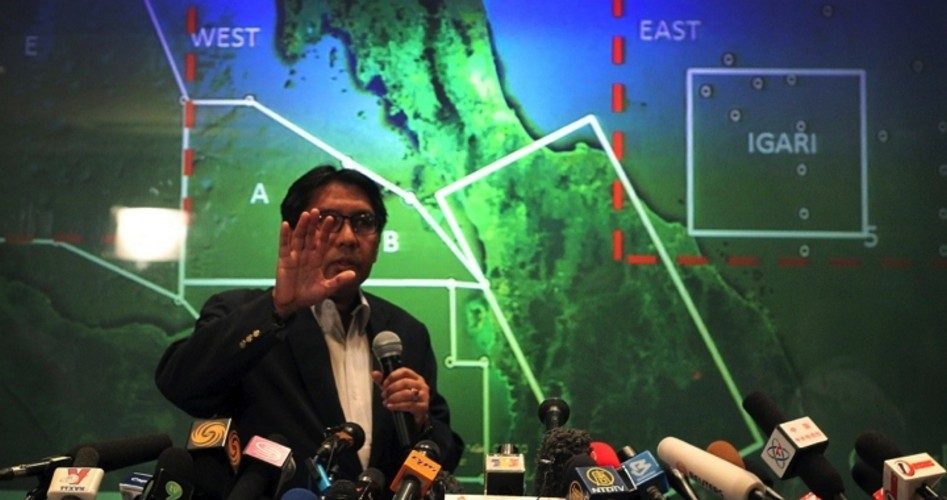
Since Malaysia Airlines Flight MH370 left Kuala Lumpur, Malaysia, shortly after midnight on March 8, and lost all contact with air traffic control an hour later while flying over the Gulf of Thailand, the world has waited anxiously for any information that might explain how and why the huge aircraft vanished.
The Boeing 777-200 was destined for Beijing, carrying an all-Malaysian crew of 12 and 227 passengers of more than a dozen nationalities, the largest number of whom were 154 from China or Taiwan and 38 from Malaysia. Its projected course should have taken it across the Gulf of Thailand, across Vietnam, then across the South China Sea to China.
Air traffic controllers in Subang Jaya, Malaysia, last had radio contact with Flight 370 around 1:30 a.m. as the plane was flying over the Gulf of Thailand between Malaysia and Vietnam, just before it was to be passed off to the Ho Chi Minh Area Control Center in Vietnam.
New Straits Times, a Malaysian newspaper, ran a story on March 9 that cited a statement from another Malaysian Airline captain who was flying 30 minutes ahead of MH370 bound for Narita, Japan. The pilot, who asked not to be identified, reported the Times, “was far into Vietnamese airspace when he was asked [by Vietnamese air traffic control] to relay, using his plane’s emergency frequency, to MH370 for the latter to establish its position, as the authorities could not contact the aircraft.”
The statement from the pilot was as follows:
The voice on the other side could have been either Captain Zaharie [Ahmad Shah] or [First Officer] Fariq [Abdul Hamid] but I was sure it was the co-pilot.
There were [sic] a lot of interference … static … but I heard mumbling from the other end.
That was the last time we heard from them, as we lost the connection.
The pilot of the lead Malaysia Airline plane said he thought nothing of losing contact with Flight MH370, and considered this to be normal, until he learned that MH370 never landed.
“If the plane was in trouble, we would have heard the pilot making the Mayday distress call. But I am sure that, like me, no one else up there heard it.
“Following the silence, a repeat request was made by the Vietnamese authorities to try establishing contact with them.”
Malaysian air force officials have reported that radar data shows that the plane might have changed course and turned back toward Kuala Lumpur before it disappeared, but since the pilots didn’t tell air traffic control that they were heading back, this only adds to the mystery.
A March 8 report from the English online version of Tuoi Tre News, a Vietnamese publication, cited a statement from the Vietnamese Navy’s High Command that flight MH370 “went down in the waters between Vietnam and Malaysia, some 153 nautical miles (300 km) off Tho Chu Island in Kien Giang Province.”
Tho Chu Island, part of the Tho Chu Islands archipelago, is in the Gulf of Thailand, west of the southern tip of Vietnam and south of Cambodia.
After debris sighted floating in the area was reported by the Vietnamese, a team from Singapore conducted a search. However, a report on March 9 in The Star, a Malaysian newspaper, cited a statement from Datuk Azharuddin Abdul Rahman (shown), director-general of Malaysia’s Department of Civil Aviation (DCA), saying that authorities have confirmed that the objects spotted floating in the sea about 100 km (62 miles) south-southwest off Tho Chu Island did not match the body of the missing aircraft.
Azharuddin added that the search radius has also been expanded from 20 nautical miles to 50 nautical miles.
“At present, we have 34 aircraft and 40 ships currently combing the search and rescue areas,” he said.
Azharuddin said that Malaysian authorities did not rule out the possibility of the aircraft being hijacked, but stressed that the priority was to locate the plane.
BBC News reported on March 10 that Azharuddin provided details of the search for Flight 370 at a Monday news conference, during which he displayed a map on which seven areas were marked to indicate areas that have already been searched by air.
Azharuddin said ships were now going back over the sectors, checking for any debris missed by the air search.
CNN quoted a statement from Azharuddin during his Monday briefing that expressed his frustration: “Unfortunately, ladies and gentlemen, we have not found anything that appear to be objects from the aircraft, let alone the aircraft.” The director further noted, “For the aircraft to go missing just like that … as far as we are concerned, we are equally puzzled as well.”
While Malaysian authorities have not ruled out the possibility of the aircraft being hijacked, there is as yet no evidence to either prove or disprove such a suspicion. And because so little has been discovered to explain the disappearance of Flight 370, almost any theory is worthy of consideration.
Several factors make a crash due to mechanical failure or pilot error unlikely. The Boeing 777-200 is considered to have an excellent safety record. A BBC reporter noted that Malaysia Airlines has a good safety record, and the Boeing 777-200ER is said to be one of the safest planes in use today because of its modern technology.
David Learmount, Flightglobal’s operations and safety editor, told BBC News: “Today’s aeroplanes are incredibly reliable and you do not get some sudden structural failure in flight. It just doesn’t happen. It just won’t happen.”
Flight 370 was piloted by an experienced crew, with its captain, Zaharie Ahmad Shah, having 18,365 hours flying experience. The first officer, Fariq Abdul Hamid, had 2,763 flying hours.
Rep. Mike Rogers (R-Mich.), chairman of the House Intelligence Committee, said on ABC’s This Week with George Stephanopoulos that the U.S. military didn’t detect any type of midair explosion.
Even if Flight 370 had experienced an abrupt and complete failure of its engines, for example, that would not explain the absence of any distress call or pre-crash or post-crash signals from the craft.
A Wall Street Journal report noted that in most cases a number of electronic transmissions help investigators and controllers track a plane’s altitude, direction, and speed. However, the transponders aboard Flight 370 did not report any malfunctions until they stopped working completely.
“Never have I seen an aircraft losing control and losing all communication” simultaneously, the Journal quoted Mark Martin of the aviation consultancy firm Martin Consulting.
When mechanical and pilot failures are thought unlikely, and the lack of any distress calls seems very odd, the possibility of a hijacking or terrorist attack naturally comes to mind. When Azharuddin was asked if the plane could have been hijacked, he answered: “We are looking at every angle, every aspect.”
One action that might hint at a hijacking was the fact that radar indicated that Flight 370 had reversed course, yet the crew never radioed air traffic controllers to indicate that they were doing so. Recall that on September 11, 2001, Flights 11 and 175, originating from Boston, diverted from their planned routes, and Flight 77, originating from Dulles and Flight 93 from Newark both reversed course. Because the hijackers had commandeered the planes and turned off the transponders on three of the four planes, air traffic controllers received no notice from the planes about their change of course, and it became difficult to track them.
While the pattern of the 9/11 hijackings does not mean that Flight 370 suffered a similar fate, it does suggest one possible explanation.
Also raising suspicions was the fact that at least two passengers on board the plane were traveling on stolen passports. The passengers used the passports — one Italian, the other Austrian — as identification when buying their tickets in Thailand last Thursday. Malaysia’s national news agency cited Home Affairs Minister Ahmad Zahid Hamidi as saying that the two people who used the passports looked “like Asians,” but declined to provide any other details.
Interpol said the stolen passports were in its database and Interpol Secretary General Ronald K. Noble said it was “clearly of great concern” that passengers were able to board an international flight with passports listed in their database.
The Wall Street Journal cited a senior U.S. official who said U.S. intelligence and law-enforcement officials were working to identify the two men with stolen passports, studying airport surveillance videos and searching for evidence such as fingerprints or other biometric identifiers.
An AP report just released as we write noted that authorities are making an investigation into the men traveling on stolen passports a high priority. Investigators traveling to the resort in Thailand where the imposters purchased their tickets to question travel agents there. It is not known whether the two had anything to do with the aircraft’s disappearance, as criminals and illegal immigrants often use stolen credentials.
Thai Police Lt. Col. Ratchthapong Tia-sood said that an Iranian man known only as “Mr. Ali” had contacted the travel agency at the resort to book the tickets for the two men.
“We have to look further into this Mr. Ali’s identity because it’s almost a tradition to use an alias when doing business around here,” said the police official.
Many explanations for the disappearance of Flight 370 have been offered, including an explosion, catastrophic engine failure, terrorist attack, extreme turbulence, and pilot error. The mystery may not be solved until the plane, especially the black boxes, are found and recovered. A New York Times report noted that “the wreckage alone could yield important clues, including whether the plane broke up in flight, suffered an explosion or had a mechanical failure.”
In the early days of aviation, mechanical failure was usually responsible for plane crashes. It is unfortunate, and ironic, that as both aircraft reliability and pilot training have become so excellent, that the possibility of deliberate destruction of an aircraft by terrorist hijackers should become a major focus of crash investigators.
Photo of Department of Civil Aviation Director General Azharuddin Abdul Rahman briefing reporters during a press conference March 10 in Sepang, Malaysia: AP Images



